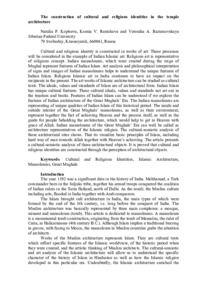Показать сокращенную информацию
The construction of cultural and religious identities in the temple architecture
| Автор | Koptseva, Natalia P. | |
| Автор | Reznikova, Ksenia V. | |
| Автор | Razumovskaya, Veronika A. | |
| Дата внесения | 2019-07-01T07:28:08Z | |
| Дата, когда ресурс стал доступен | 2019-07-01T07:28:08Z | |
| Дата публикации | 2018-07 | |
| Библиографическое описание | Koptseva, Natalia P. The construction of cultural and religious identities in the temple architecture [Текст] / Natalia P. Koptseva, Ksenia V. Reznikova, Veronika A. Razumovskaya // Journal of Siberian Federal University: Humanities & Social Sciences. — 2018. — Т. 11 (№ 7). — С. 1021-1082 | |
| URI (для ссылок/цитирований) | http://elib.sfu-kras.ru/bitstream/handle/2311/71770/Koptseva.pdf?sequence=1 | |
| URI (для ссылок/цитирований) | https://elib.sfu-kras.ru/handle/2311/111093 | |
| Аннотация | Cultural and religious identity is constructed in works of art. These processes will be considered in the example of Indian Islamic art. Religious art is representative of religions concept. Indian mausoleums, which were created during the reign of Mughal represent features of Indian Islam. Art analysis and philosophical interpretation of signs and images of Indian mausoleums helps to understand the unique features of Indian Islam. Religious Islamic art in India continues to have an impact on the recipients in the present. The art works of Islamic architecture can be studied as cultural texts. The ideals, values and standards of Islam are of architectural form. Indian Islam has unique cultural features. These cultural ideals, values and standards not set out in the treatises and books. Features of Indian Islam can be understood if we explore the features of Indian architecture of the Great Mughals’ Era. The Indian mausoleums are representing of unique qualities of Indian Islam of this historical period. The inside and outside interior of the Great Mughals’ mausoleums, as well as their environment, represent together the fact of achieving Heaven and the process itself, as well as the guide for people beholding the architecture, which would help to get in Heaven with grace of Allah. Indian mausoleums of the Great Mughals’ Era can well be called as architecture representatives of the Islamic religion. The cultural-semiotic analysis of these architectural sites shows. That its visualize basic principles of Islam, including hard way of man towards Allah together with Heaven’s achieving. The article presents a cultural-semiotic analysis of these architectural objects. It is proved that cultural and religious identities are constructed through the perception of architectural objects. | |
| Тема | Cultural and Religious Identities | |
| Тема | Islamic Architecture | |
| Тема | Mausoleums | |
| Тема | Great Mughals | |
| Название | The construction of cultural and religious identities in the temple architecture | |
| Тип | Journal Article | |
| Тип | Journal Article Preprint | |
| Страницы | 1021-1082 | |
| ГРНТИ | 13.11.47 | |
| Дата обновления | 2019-07-01T07:28:08Z | |
| DOI | 10.17516/1997-1370-0291 | |
| Институт | Гуманитарный институт | |
| Институт | Институт экономики, управления и природопользования | |
| Подразделение | Кафедра культурологии | |
| Подразделение | Кафедра делового иностранного языка | |
| Журнал | Journal of Siberian Federal University | |
| Квартиль журнала в Scopus | без квартиля |

